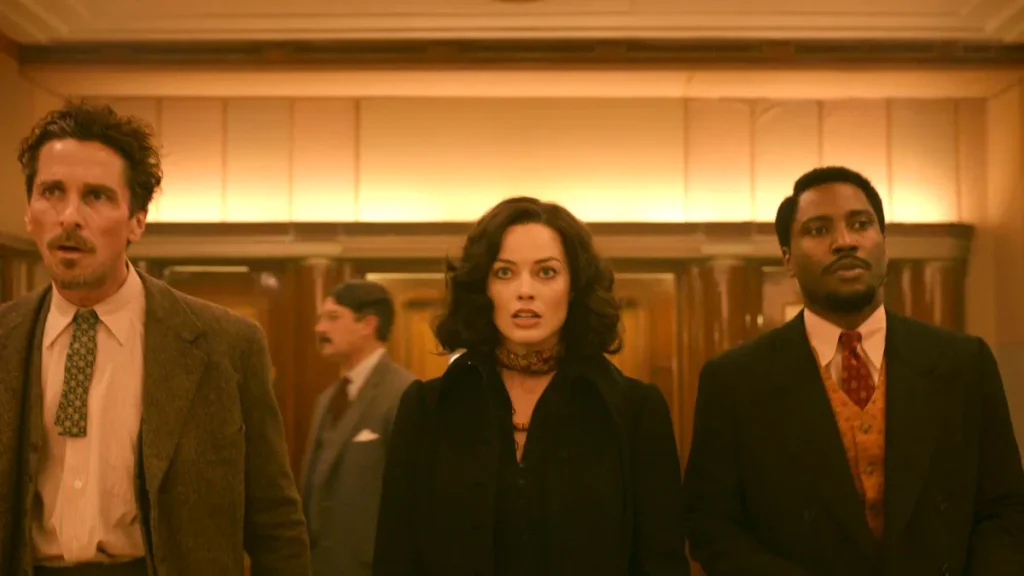“A lot of this happened,” teases the opening card of David O. Russell’s rambunctious ensemble comedy “Amsterdam,” a loony early-’30s social satire that cartwheels through a little-remembered episode in American history when fascists attempted to overthrow the government. Russell sees parallels between this troubling chapter of our nation’s history and our present, as national divisions threaten to overwhelm American democracy, but the writer-director has complicated the plot — the movie’s plot, not the larger conspiracy on which it is based — to the point where audiences are bound to be perplexed. Instead of wondering which parts are true and which are made up, they’re more likely to be left wondering, “What the hell is going on?” for the better part of 134 minutes.
Confusion is neither unusual nor unwelcome in comedic capers and whodunits, where the fun often stems from being thrown around by unexpected developments (what happens to Taylor Swift in this film qualifies as such a twist). Russell is back in free-wheeling “American Hustle” mode, and his appetite for chaos can be uniquely exhausting, and despite the oddball ensemble’s intelligent ideas and a smorgasbord of against-type performances from A-list names, “Amsterdam” is less than the sum of its parts.
The plot revolves around a friendship between three Americans who become embroiled in a complex political plot. The trio was never happier than when they lived together in Amsterdam following World War I. Encouraged to enlist (and possibly die) by his high-society in-laws, Dr. Burt Berendsen (Christian Bale) lost an eye and half his face in the war but made a lifelong friend in Harold Woodman (John David Washington), a Black soldier who was forced to fight in French uniform because American troops refused to integrate.
Burt and Harold were both severely injured during the war, but they had the good fortune to meet a brave nurse named Valerie Voze (Margot Robbie) during their recovery. Bale digs deep into this latest character, emulating a young Peter Falk’s disheveled look and distracted demeanor (right down to Burt’s wonky glass eye, which never quite aligns with the working one), while Washington appears strangely superficial in comparison, his face fixed in that same blank expression that’s fast becoming his signature. Robbie immediately dazzles us with her defiance, speaking French (enough to confuse us as to her character’s origins) as she breaks the boys out of the field hospital.
Valerie collects shrapnel from her patients, but instead of discarding it, she uses the twisted metal in artistic projects such as teapots made of bomb parts and surrealist photo collages similar to those created by Man Ray and Grete Stern in the 1930s. Burt is also a sculptor in the medical arts, reconstructing the faces of other disfigured veterans (while testing experimental painkillers on himself). For a brief, glorious moment in Amsterdam, the friends are spared the stresses of their lives — and, in Burt’s case, his wife (Andrea Riseborough) — back in America, their shenanigans somehow sponsored by two lithophile spies (Michael Shannon and Mike Myers, the latter heavily disguised and accented), who promises, “We’ll come a-calling at some point in the future.”
Russell’s shtick, based on that snarky true-story setup, involves stretching credibility to the breaking point — except the three main characters are complete fabrications, which somewhat undercuts the joke. Nonetheless, we are concerned to learn that, since her return, Valerie has been drugged up and kept indoors under the guise of a “hereditary nervous disorder” by her brother Libby, the wife of Tom (Rami Malek) (Anya Taylor-Joy). Those two have some troubling political beliefs that are best left to be discovered in the film, though it’s worth noting that the New York Veterans Reunion, where everything comes to a head, was inspired by a real-life event. The evening’s guest speaker, played by Robert De Niro, was inspired by real-life war hero Major General Smedley Butler, who exposed the Business Conspiracy.
Russell is correct to remind Americans of this heinous chapter in their history (skip this paragraph to avoid spoilers), as history books tend to exaggerate Mussolini and Hitler’s domestic support in the run-up to World War II. Philip Roth’s novel “The Plot Against America” imagines an alternate reality in which Franklin D. Roosevelt is defeated by a Nazi-supporting Charles Lindbergh (adapted for HBO around the same time “Amsterdam” was filming). Russell highlights more heinous plans to depose the president in this section. Judy Becker, the film’s production designer, drew inspiration from 1930s rallies, such as the one Marshall Curry documented in his Oscar-nominated doc short “A Night at the Garden, “down to the George Washington portrait that hangs behind the dais.
Russell’s truth-telling, the think-for-yourself political message is ultimately what makes “Amsterdam” appealing, even though the film is marketed primarily on the popularity of its cast. That’s a risky bet for such an expensive film, given that almost none of the stars deliver the thing that fans love most about their personas — except Chris Rock, who gets to opine on white supremacy. It’s shot beautifully by cinematographer Emmanuel Lubezki, whose swooning mix of Steadicam and handheld techniques has given recent films by Terrence Malick and Alejandro G. Iárritu an almost godlike grandeur, though that fluid style combines rather oddly with Russell’s more erratic comedic sensibilities.
The outcome has all the hallmarks of a flop, but it takes a strong enough anti-establishment stance — and does so with wit and originality — to earn a cult following. There’s too much ambition in this film to dismiss it, even if “Amsterdam,” like the history it depicts, takes years to be rediscovered and understood.
